
One of my favorite books in elementary school was 13 Alabama Ghosts and Jeffrey by Kathryn Windham and Margaret Figh. Most of the stories were rather tame, but the book had a spooky, shadowy photograph of a ghost named Jeffrey who has made his presence known in the author Windham’s house since 1966. (Poor Jeffrey has been blamed for everything from hiding socks to scaring the cat.) My interest wasn’t piqued enough to consider ghosts much further, but when I began my musical studies at Harding University in 1980, I heard stories that our music building was haunted by an apparition known affectionately as Galloway Gertie.
In a spot where Harding University’s administration building now stands, there once was a gothic-like dormitory named Godden Hall. As legend has it, a young lady named Gertrude bid her date goodnight and headed to her room, her white evening gown flowing behind her. As she neared her room, she heard a noise in the direction of the elevator shaft and turned to investigate. A terrible scream brought many of the girls out of their rooms in a panic. Gertrude was found dead at the bottom of the shaft.
After her death, there were reports of the bell in Harding’s old tower ringing at midnight, organ music at odd hours, and sightings of a young woman in a flowing white gown wandering the campus grounds. Godden Hall was torn down in 1951, and in 1953 bricks from Godden Hall were used in the construction of the music building, where she is said to have made her new home. However, she never visited me during any of my late-night practice sessions. I am not sure whether to be offended or not.
Upon recent investigation, I was surprised to learn that ghosts apparently frequent many of our nation’s universities. There are actual rankings of the most haunted universities in the United States. I could only locate one that had its music building haunted, so in that respect my alma mater is almost unique. A Virginia institution, Hollins University, has a haunted building named Presser Hall, which is home to the music department. It was there, so the story goes, that a female student began a relationship with her piano teacher, who later murdered her during a lesson. Some say that her ghost still haunts the building as a dark figure visible in a window.
Ghosts have not only inspired stories, but music as well; there are many band pieces inspired by ghosts and other scary creatures. Here is my list of suggested selections to haunt your next concert program. If October is too early to get a concert together, may I suggest a “Halloween in January” concert – we are calling ours Fright Night. (The grade 5 works are well known enough that no descriptions were included.)
Grade 1
Danse Macabre by Camille Saint-Saens, arr. by Michael Story. Written to depict the French superstition that on Halloween, Death appears to summon the dead to dance. In 3/4 time, good flute players will be required for this one. (Alfred)
Dr. Rockenstein arranged by Steve Hodges. In the Hall of the Mountain King and other scary melodies fill this piece with an added rock beat. Makes a good closer. (Alfred)
Ghost Lights by Timothy Loest. Inspired by the dancing and blinking Brown Mountain Lights of North Carolina. (FJH)
Ghost Ship by Michael Story. In 1872, the merchant ship Mary Celeste went missing, but was found a few months later. The problem? The crew had disappeared. (Alfred)
Ghosts in the Graveyard by Scott Watson. Based on a math game of the same title. (Alfred)
Haunted Clocks by Brian Balmages. This piece features simple aleatoric passages that add creepiness to this musical tour of a haunted clock factory. (FJH)
Tunes That Go Bump in the Night arranged by Mark Williams. A medley of The Sorcerer’s Apprentice, In the Hall of the Mountain King, and Funeral March of the Marionette. (Alfred)
Grade 2
A Christmas Tale (Beware the Krampus) by Randall Standridge. According to some European Christmas traditions, Saint Nick does not work alone, he travels with Krampus, who doles out punishment to bad boys and girls. The spooky narration frames the piece as The Ukranian Bell Carol, Up on the Housetop, Jolly Old St. Nicholas, and other holiday favorites are carefully distorted. It may be the creepiest thing you ever play. (Alfred)
Apparitions by Brian Balmages. Paints a portrait of lonely apparitions that appear and fade away. An optional but important piano part is included. (FJH)
Fright Night arranged by James Kazik. Six classic scary themes including Jaws and Thriller. (Hal Leonard)
Ghost in the Machine by George Sweet. A huge ancient machine is inhabited by a ghost. (Carl Fischer)
Ghost Band by Robert W. Smith. Screams and other vocal effects haunt this fun piece. (C.L. Barnhouse)
Ghosts of the Lost Ship by Tyler Grant. Cinematic sounding score of pirate naval battles. (FJH)
The Haunted Carousel by Erika Svanoe. Althought the part is covered elsewhere, an eerie and effective theremin part is included that can also be produced on an amplified iPad with a GarageBand application. (Wingert-Jones)
Through Darkened Sleepy Hollow by Erik Morales. An exciting work inspired by the Headless Horseman’s pursuit of Ichabod Crane in The Legend of Sleepy Hollow. (FJH)
Grade 3
Ghost Fleet by Robert Sheldon. Long-forgotten warships return for battle in this contest-worthy piece. (Alfred)
Ghosts, Goblins, and Witches by James Swearingen. Three-movement suite with titles Ghostly Procession, Dancing with the Goblins, and Witches Brew: The Final Spell. (C.L. Barnhouse)
Ghost Riders by Roland Barrett. Phantom cowboys ride in the American West. (FJH)
Haunted Carnival by Rob Grice. Piece with haunting energy and an eerie middle section. (Hal Leonard)
House of Horrors arranged by Tom Wallace. Medley of Bach’s Toccata and Fugue, Mussorgsky’s Night on Bald Mountain, and Gounod’s Funeral March of a Marionette. (Arrangers)
The Headless Horseman by John Prescott. A good piece for exposing students to 6/8 time. (Wingert-Jones)
Nevermore by Brian Balmages. Inspired by Edgar Allan Poe’s The Raven, this piece has mixed meters that give it drive, and a piano part that adds to the eeriness of the slow sections. (FJH)
The Witching Hour by Randall Standridge. Four interesting sections are introduced by the tolling of chimes. (Grand Mesa)
Grade 4
Carmina Burana by Carl Orff, arranged by Jay Bocook. Challenging version that combines elements of movements one and two from the original. (Hal Leonard)
Ghost Dances by Roland Barrett. Inspired by the Lakota Sioux massacre at Wounded Knee in 1890, this contemporary sounding work uses melodic fragments from a Sioux ghost dance. (Alfred)
The Witch and the Saint by Steven Reineke. Five sections of this ten-minute tone poem tell the turbulent tale of twin sisters born in Germany in 1588. (C.L. Barnhouse)
Grade 5
Dies Irae (Verdi Requiem) by Giuseppe Verdi, arranged by Jay Bocook. (Hal Leonard)
Dream of a Witches’ Sabbath from Symphonie Fantastique by Hector Berlioz, arranged by R. Mark Rogers. (Southern)
The Flying Dutchman (Overture) by Richard Wagner, transcribed by Mark Hindsley. (Hindsley Transcriptions)
Ghost Train, Movement 1 by Eric Whitacre. (Hal Leonard)
The Sorcerer’s Apprentice by Paul Dukas, arr. by Mark Hindsley. (Hindsley Transcriptions)
Toccata and Fugue in D Minor by J.S. Bach, arranged by Mark Hindsley. (Hindsley Transcriptions)






